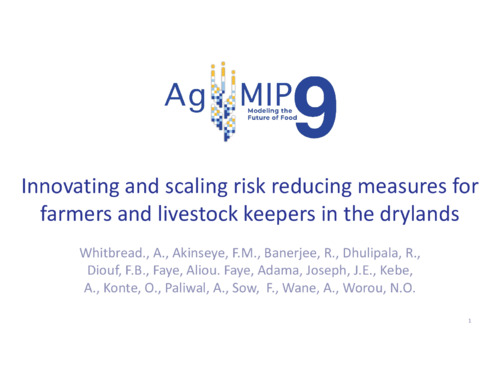Innovating and scaling risk reducing measures for farmers and livestock keepers in the drylands
Abstract
In the drylands, low and variable rainfall patterns often leave poor communities dependent on rainfed pastoral and agropastoral production highly vulnerable. Risk reducing measures in the form of innovative insurance schemes for livestock producers, or climate risk tools for tactical agronomic management for farmers, have been piloted by the CGIAR and its partners in many dryland geographies. At their core are the use of crop and pasture models, spatial data from remotely sensed imagery, historical time series weather datasets which, when linked to expert knowledge of the system, are used together to develop triggers for decision making or action. For example, for pastoralists in Kenya, Ethiopia and Somalia, the index-based livestock insurance (IBLI) products linked to fodder availability (biomass), have been scaled to the regional level as de-risking instruments. In crop-based systems, a decision support tool called ‘iSAT’ defines a process to create context specific climate informed agro-advisories for use in tactical agronomic decisions making at the farm level. For livestock keepers in mixed crop-livestock systems the decisions which are linked to climate throughout the life-cycle of fodder and animal components are used to develop actionable management strategies. In these examples, models have been used in a participatory mode to develop scenarios that farmers face in their day-to-day management. When linked to medium range and seasonal climate forecasts, future climate change predictions, bioeconomic analysis for example, the scenarios can be communicated to decision makers in a: (i) strategic mode to design more resilient farming systems; or (ii) in a tactical mode as the prevailing season unfolds leading to more informed climate risk management. Low-cost internet, affordable smartphones, mobile network penetration, cloud computing and novel communication methods (e,g. SMS and IVR), increasingly offer unprecedented opportunities for the dissemination of information to farmers through digital channels and to re-imagine agriculture advisory. Digital technologies also enable innovative and affordable methods of acquiring and sharing data, ground truthing, and user feedback especially in data sparse and hostile environments.

